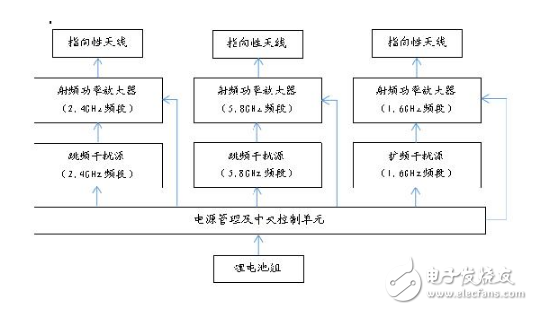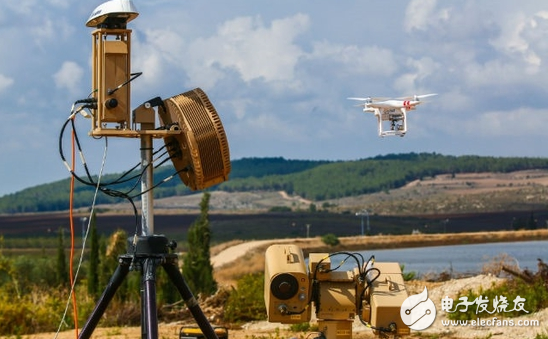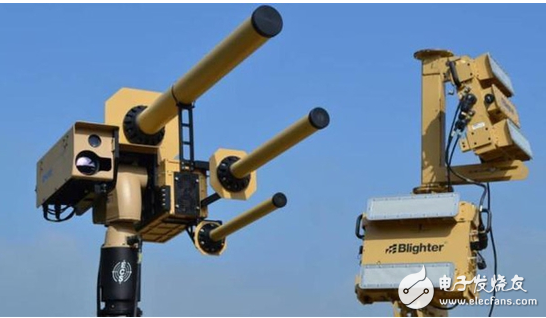Natural enemies are an indispensable part of the development of natural biological chains. Some fast-rising species must produce natural enemies to curb the harm caused by their crazy and disorderly growth. This principle may also be suitable for certain areas of technology, such as drones.
In recent years, drones (herein referred to as civilian multi-axis aircraft) are spreading at an unprecedented rate, and the concerns about safety have increased. Many relevant departments and even individuals want to take some measures to prevent drones from flying into sensitive areas. In order to achieve this goal, many methods can be used, such as training the eagle to fly to capture.
UAV jammer composition and principleThe device consists of a handheld main unit and a battery pack. The handheld host is designed as a three-band transmitter antenna, which can simultaneously generate UAV flight control interference signals and satellite positioning interference signals in the 2.4GHz/5.8GHz band, and through the uplink flight control channel and satellite positioning channel of the UAV. Blocking interference, so that it loses the flight control command and satellite positioning information, so that it can not fly normally. According to the design of the drone, it will produce the control effect of returning, landing and falling.

In the offensive and defensive situation, there is usually a distance between the operator of the drone and the sensitive area that needs to be fortified. The drone takes off from the vicinity of the operator and then gradually flies to the fortification area. When the drone reaches the vicinity of the fortification area and is capable of carrying out effective investigation or sabotage activities, the distance from the drone to the fortified area is usually much closer than it is to the operator.
In the above situation, all the uplink signals sent by the operator (transmitted from the ground to the drone) will be weak because of the distance. With the same power, the defender is closer to the drone and the signal will be stronger than the operator. The down signal received by the defender will also be stronger than the manipulator. However, the defense target for the downlink signal is that the operator does not receive it, and the distance from the drone to the operator is similar to the distance from the defender to the operator. Therefore, the blocking of the downlink signal does not occupy the terrain advantage.
From the above analysis, it can be seen that the interference uplink signal is more advantageous. It happens that the uplink signal is usually a remote control signal, which is directly related to the control of the drone. If the uplink signal is disturbed, the drone will lose its immediate control and can only operate according to the preset steps of the program (usually landing or hovering). The downlink signals are mainly telemetry and images. Although there may be sensitive information, it is less important than the control signal. In addition, the defender does not have an advantage in the situation, and usually adopts a laissez-faire attitude to the downlink signal.
GPS relies on medium orbit satellites. In general, the signal has reached tens of thousands of kilometers to reach the surface of the earth, which is already very weak. Therefore, it is relatively easy to interfere with the GPS signal when the drone is very close to the defender. If you want to deceive it, you need to use more complicated means to simulate GPS satellites, which is much more difficult.

At present, national anti-UAV technologies are mainly divided into three categories.
First, the interference blocking class is mainly realized by techniques such as signal interference and sound wave interference.
Second, directly destroy the class, including the use of laser weapons, the use of drones to counter drones.
Third, monitoring and control, mainly through hijacking radio control and other means.
The second type of technology is mainly used in the military field. The following discussion on the first and third types of anti-UAV technology will talk about how to use information technology to counter consumer-grade UAVs.
At present, all civil drones need to use radio technology to achieve positioning, remote control, image transmission and other functions. Of course, some special-purpose drones can use methods such as terrain matching, image recognition, and high-precision inertial navigation to determine their position and perform tasks autonomously, but they are not yet popular in the civilian field. Since the drone must use radio technology, it can interfere with the radio to achieve the goal of getting the drone out of control or reentry.
In just a few years, drones have moved from niche to popular. Because of its rapid development, the safety hazards and accidents caused by the "black fly" of drones have been repeatedly banned, so anti-UAV systems have emerged. So what kind of methods do the "natural enemies" of these drones use to encircle drones?
Block interference typeThis type is more suitable for the current UAV flooding and widely used anti-UAV mode. The interference blocking type anti-UAV strategy is widely used to transmit directed sound waves or radio frequencies to the target drone, interfere with the hardware of the drone or cut off the communication between the drone and the remote controller, thereby forcing the unmanned The aircraft landed or returned on its own.
Signal interferenceIn general, the simplest and straightforward way to block interference is signal interference, which is relatively low in technology and less costly. At present, most UAVs on the market use a combination of GPS satellite navigation system and inertial navigation system. It is not difficult to make GPS signals interfere. The anti-UAV system only needs to transmit to the target UAV. The directional radio frequency of the power can be obtained. After the GPS signal of the drone is interfered, the accurate self-coordinate data cannot be obtained, which will cause the drone to lose control to a certain extent, so that the operation fails. However, this method is also the mildest of the many "encirclement and drooping" drones. It does not allow the drone to fall. It is a way to reduce the "harmful purpose" of drones by interference.

In terms of signal interference, the acoustic interference is much higher, and the degree of damage is higher than the signal interference.
In August last year, researchers from the Korea Advanced Science and Technology Research Institute (KAIST) published a report saying that a new type of "sound wave interference anti-UAV system" was developed. Unlike signal interference, this method is used. Sound waves interfere with the hardware of the drone, making it incapable of working.
Inside the drone is an important component, the gyroscope, which provides the drone with information such as tilt, rotation and direction of the body to maintain the balance of the body. Researchers in South Korea have shown that when the acoustic frequency is consistent with the natural frequency of the drone gyroscope, resonance occurs, making the gyroscope unable to work properly, causing the drone to fall. Although the method of interfering with hardware is more violent and more direct, the relative signal interference is insufficient. The aiming and tracking of acoustic interference is not as stable as GPS interference, and the cost is expensive. It is not suitable for use in the public anti-UAV system. .
Radio wave interferenceWhen it comes to interference-blocking anti-UAV systems, I have to mention the AUDS system, which is the British company Blighter Surveillance Systems, Chess Dynamics and Entres Control Systems. The anti-UAV system jointly developed by Enterprise Control Systems is considered to be the most famous anti-UAV device last year. The system mainly uses a high-power radio wave to eliminate the drone. Simply put, this radio wave can effectively block drone communication and shut down the drone in midair. The defense system also has a very long attack range. It can attack threat drones 1.6 kilometers away. It only takes 10-15 seconds to aim at the target. It can also launch a "bee colony attack" on the drone, and shoot down multiple unmanned targets at one time. Machine, the threat to the black flying drone is very big.

The latest Windows has multiple versions, including Basic, Home, and Ultimate. Windows has developed from a simple GUI to a typical operating system with its own file format and drivers, and has actually become the most user-friendly operating system. Windows has added the Multiple Desktops feature. This function allows users to use multiple desktop environments under the same operating system, that is, users can switch between different desktop environments according to their needs. It can be said that on the tablet platform, the Windows operating system has a good foundation.
Windows Tablet,New Windows Tablet,Tablet Windows
Jingjiang Gisen Technology Co.,Ltd , https://www.jsgisengroup.com
